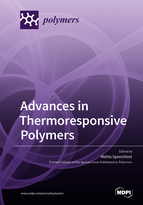Advances in Thermoresponsive Polymers
A special issue of Polymers (ISSN 2073-4360). This special issue belongs to the section "Smart and Functional Polymers".
Deadline for manuscript submissions: closed (25 January 2022) | Viewed by 32939
Special Issue Editor
Interests: polymer chemistry; drug delivery; polymer nanoparticles; stimuli-responsive polymers; biodegradable nanoparticles; ring opening polymerization; RAFT polymerization; from batch to continuous
Special Issue Information
Dear Colleagues,
Thermoresponsive polymers are materials which are able to phase separate from the solvent with a sharp and often reversible transition in response to thermal stimuli. The possibility of inducing a dynamic response through temperature changes, which are commonly encountered in many applications or can be artificially applied at low cost and avoiding the contamination of the fluid, makes these materials extremely appealing. As a result, thermoresponsive polymers are currently being investigated for application in many fields, ranging from biomedicine to optical sensors, chromatography, as well as oil and gas. Despite being a rather recent research area, the first examples of thermoresponsive systems are now appearing on the market. Given the attractiveness of these polymers and the extensive research efforts made in recent years, this Special Issue aims to report the recent advances on the topic, from both theoretical and applied perspectives. Therefore, contributions on modelling and simulations as well as on experimental work are welcome for this Special Issue.
Dr. Mattia Sponchioni
Guest Editor
Manuscript Submission Information
Manuscripts should be submitted online at www.mdpi.com by registering and logging in to this website. Once you are registered, click here to go to the submission form. Manuscripts can be submitted until the deadline. All submissions that pass pre-check are peer-reviewed. Accepted papers will be published continuously in the journal (as soon as accepted) and will be listed together on the special issue website. Research articles, review articles as well as short communications are invited. For planned papers, a title and short abstract (about 100 words) can be sent to the Editorial Office for announcement on this website.
Submitted manuscripts should not have been published previously, nor be under consideration for publication elsewhere (except conference proceedings papers). All manuscripts are thoroughly refereed through a single-blind peer-review process. A guide for authors and other relevant information for submission of manuscripts is available on the Instructions for Authors page. Polymers is an international peer-reviewed open access semimonthly journal published by MDPI.
Please visit the Instructions for Authors page before submitting a manuscript. The Article Processing Charge (APC) for publication in this open access journal is 2700 CHF (Swiss Francs). Submitted papers should be well formatted and use good English. Authors may use MDPI's English editing service prior to publication or during author revisions.
Keywords
- thermoresponsive polymers
- lower critical solution temperature
- upper critical solution temperature
- phase separation
- reversible systems
- mechanism of phase transition
- applications of thermoresponsive polymers
- biomedical field
- oil and gas
- chromatography
- sensors







